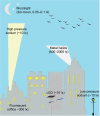Hormonally mediated effects of artificial light at night on behavior and fitness: linking endocrine mechanisms with function
- PMID: 29545373
- PMCID: PMC5897701
- DOI: 10.1242/jeb.156893
Hormonally mediated effects of artificial light at night on behavior and fitness: linking endocrine mechanisms with function
Abstract
Alternation between day and night is a predictable environmental fluctuation that organisms use to time their activities. Since the invention of artificial lighting, this predictability has been disrupted and continues to change in a unidirectional fashion with increasing urbanization. As hormones mediate individual responses to changing environments, endocrine systems might be one of the first systems affected, as well as being the first line of defense to ameliorate any negative health impacts. In this Review, we first highlight how light can influence endocrine function in vertebrates. We then focus on four endocrine axes that might be affected by artificial light at night (ALAN): pineal, reproductive, adrenal and thyroid. Throughout, we highlight key findings, rather than performing an exhaustive review, in order to emphasize knowledge gaps that are hindering progress on proposing impactful and concrete plans to ameliorate the negative effects of ALAN. We discuss these findings with respect to impacts on human and animal health, with a focus on the consequences of anthropogenic modification of the night-time environment for non-human organisms. Lastly, we stress the need for the integration of field and lab experiments as well as the need for long-term integrative eco-physiological studies in the rapidly expanding field of light pollution.
Keywords: ALAN; Glucocorticoid; Hormones; Light pollution; Melatonin; Metabolism; Sleep; Stress; Thyroid; Urban ecology.
© 2018. Published by The Company of Biologists Ltd.
Conflict of interest statement
Competing interestsThe authors declare no competing or financial interests.
Figures



References
Publication types
MeSH terms
Substances
Grants and funding
LinkOut - more resources
Full Text Sources
Other Literature Sources
Medical
Research Materials
Miscellaneous

